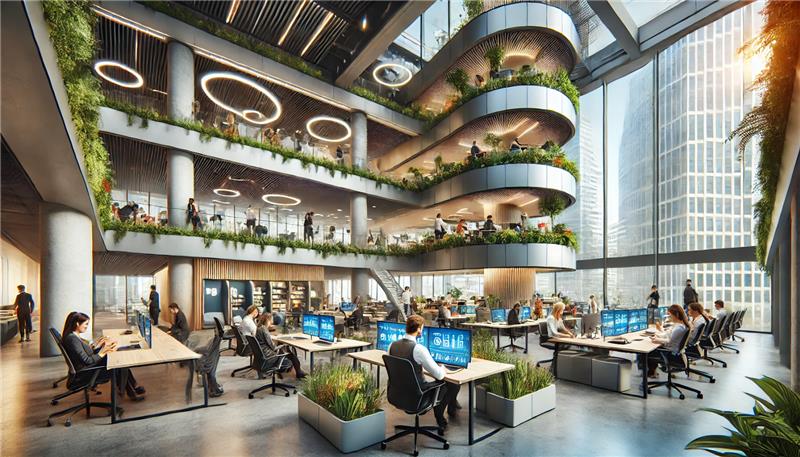In the fast-evolving world of work, the traditional office space is no longer the only option. The rise of hybrid models, flexible working hours, and remote work has led to an increased demand for workspace flexibility. As organizations navigate the post-pandemic world, understanding the trends shaping the future of workspaces is crucial. Let’s dive into how workspaces are evolving today and what the future holds for businesses, employees, and coworking spaces alike.
1. The Rise of Hybrid and Remote Work Models
The pandemic changed the way we work, with many businesses transitioning to remote work as a necessity. However, over time, organizations realized the potential benefits of a hybrid work model, where employees split their time between the office and working remotely. This shift has made flexibility a priority for companies looking to attract and retain talent.
The future of workspace flexibility is rooted in the ability to adapt to different working styles. For businesses, providing flexible work options—whether it’s choosing to work from home, a coworking space, or the office—has become a significant aspect of employee satisfaction.
2. Coworking Spaces: The New Face of Flexibility
Coworking spaces have gained popularity as businesses seek more flexible and cost-effective workspace solutions. These spaces cater to a wide range of professionals, from freelancers and startups to large enterprises looking for scalable solutions.
The flexibility of coworking spaces lies in their ability to offer short-term leases, customizable office configurations, and access to a network of like-minded professionals. Coworking spaces are not just places to work—they are hubs for innovation, collaboration, and growth.
At Provyz Coworking Space, for example, individuals and businesses can access private cabins, hot desks, and meeting rooms, all equipped with essential amenities. This flexibility allows companies to scale and adapt their workspace needs as required.
3. The Importance of Technology Integration
As workspaces continue to evolve, technology plays a crucial role in shaping the future. The integration of advanced technologies, such as AI-driven workplace management tools, remote collaboration platforms, and IoT (Internet of Things) solutions, enables seamless transitions between remote and office work.
In the future, companies will leverage smart office technology to optimize workspace usage, reduce costs, and create environments that encourage productivity and innovation. From booking systems to intelligent temperature controls, these technological advancements are setting the stage for more adaptable and efficient workspaces.
4. Employee-Centric Workspaces: Designing for Flexibility
One of the key trends shaping the future of workspaces is the focus on employee experience. Workspaces of the future will not only prioritize flexibility but also create environments that promote employee well-being, creativity, and collaboration.
Businesses are recognizing that offering a variety of workspace options—quiet zones, collaborative spaces, lounges, and even outdoor areas—helps employees feel more engaged and motivated. At Provyz, for example, spaces like the green area, courtyard, and cafe offer employees a chance to unwind, collaborate, or focus, creating a dynamic work environment.
5. Sustainability and Eco-friendly Designs
Another important aspect of future workspace flexibility is sustainability. As businesses increasingly focus on reducing their environmental impact, office spaces will become more eco-friendly. This includes using energy-efficient designs, reducing waste, and incorporating green building materials.
Flexible workspaces are leading the way by adopting sustainability practices, such as incorporating green spaces and energy-efficient infrastructure. As the demand for eco-conscious workplaces grows, businesses will need to adapt their workspaces to align with sustainability goals.
6. Adapting to Employee Needs and Well-being
The future of workspace flexibility isn’t just about the physical space—it’s about creating environments that align with employees’ needs and preferences. As the lines between work and personal life continue to blur, organizations must focus on enhancing work-life balance through flexible scheduling, wellness programs, and stress-reducing workspace designs.
By offering options for quiet workspaces, social areas, and communal environments, businesses can foster an atmosphere where employees feel empowered and motivated to perform their best.
Conclusion
The future of workspace flexibility is bright and diverse. With the rise of hybrid and remote work, coworking spaces, and innovative technologies, businesses have the opportunity to create more adaptable and employee-centric work environments. As we look to the future, the key will be staying ahead of trends, embracing change, and continuously adapting to the evolving needs of the workforce.
Whether through flexible office layouts, smart technologies, or employee-focused designs, the workspace of tomorrow will reflect the growing demand for flexibility, sustainability, and well-being. As we continue to adapt to the new normal, businesses and coworking spaces alike must be ready to meet the challenges and opportunities that the future holds.
